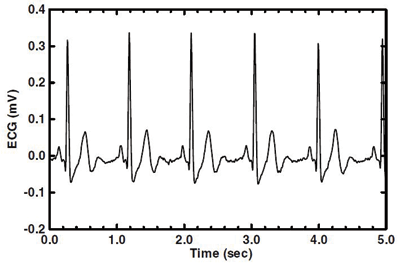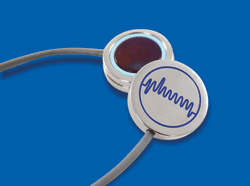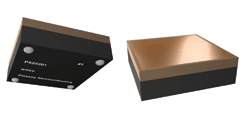Sensor requirements for portable ECG monitoring
Advances in active capacitive electrodes make it easier to integrate ECG sensing into handheld devices for long-term care
BY PHIL WATSON
Research Assistant
University of Sussex, U.K.
www.sussex.ac.uk
The electrocardiogram (ECG) is used to diagnose and monitor a multitude of conditions affecting the heart. More than just a measure of pulse rate, the ECG reveals the complex electrical activity of the heart’s natural pacemaker. Clinicians can use this information to monitor the overall health of the heart, and measure the damage caused by common heart conditions such as chronic high blood pressure.
Despite its utility, ECG monitoring has long been confined to the doctor’s office. Trained professionals are required to carry out the skin preparation and electrode application to acquire an ECG. The industry standard Silver-Silver Chloride (Ag-AgCl) electrodes must be correctly applied to the patient’s chest with a conductive (wet) gel, and are usually disposed of after use. Not only does this electrode technology require expert application, but it can cause considerable patient discomfort and skin irritation, particularly in long-term monitoring.
With aging populations and limited healthcare resources, medical technology is increasingly being relied upon to extend wellness monitoring into the home. By allowing patients to monitor their own heart condition without visiting their doctor, and by leveraging the latest telehealth technologies, the burden of health monitoring on both the patient and the healthcare system can be reduced.
Active, dry electrodes can be used to acquire high resolution ECGs without any of the special preparations required with conventional wet electrodes. These electrodes rely on ultra-high-impedance amplifier technology to be able to detect the small (1 to 5-mV) ECG signals from the surface of the skin, without having to make a direct electrical contact. The high impedance of these amplifiers mean that an insulated electrode may be used to form a capacitor between the skin and the electrode amplifier, without requiring any gels, glues, or skin preparation.
Active electrodes
From an electrical engineer’s perspective, the heart is a multi-polar voltage source, developing a complex pattern of electrical signals across the body. Clinicians refer to a standard set of “leads,” each lead referring to the voltage sensed at a different point on the surface of the body. The simplest ECG signal is the I-lead, which is the signal measured differentially across the chest.
A conventional ECG system would require two wet electrodes on the chest of the subject, and possibly an extra lead to ground the subject. The ECG shown in Fig. 1 has been acquired by having the patient grasp a pair of dry active sensors, simply holding one in each hand between thumb and forefinger.

Fig. 1: The I-lead ECG shown here was acquired using an active, dry electrode system.
An active electrode consists of an ultra-high-impedance amplifier integrated with an isolated electrode structure. The electrode has a dielectric surface so that it does not make an electrical connection with the skin; instead a capacitor is formed across the dielectric. For a thin dielectric and a circular electrode around 10 mm in diameter, this capacitance is only several hundred pico-Farads. Because the active amplifier loads this capacitor (see Figure 2 ), the input impedance of the amplifier must be very high: less than 10 pF of input capacitance and greater than 50 GΩ input resistance. The high input resistance is required to ensure that the low frequency response across the electrode capacitance extends to 0.1 Hz, the response range required for a diagnostic quality ECG.

Fig. 2.An active electrode amplifier must have high input resistance and low input capacitance. Here, capacitor Cel couples the voltage source VECG to the amplifier, which has an input impedance represented by Rin and Cin .
This ultra-high impedance must also be achieved whilst maintaining low noise. At such high source impedances, current and thermal noise contributions dominate. Current noise must therefore be much less than a few femtoamperes per root hertz. A range of new ultra-high-impedance amplifiers, the electric potential IC (EPIC) from Plessey Semiconductors (see sidebar, Commercialization) , meets these specifications, and will shortly be available with an integrated electrode structure for dry ECG sensing.
Because active electrodes require no special preparation or expert intervention, ECG monitoring is close to being available to any user who wishes to monitor their heart; whether to provide their cardiologist with an ECG measurement from their own home or just to monitor their fitness program at the gym. ■
Commercialization
The EPIC sensor has emerged from an EPSRC Basic Technology research program conducted over the last decade at the University of Sussex, U.K., and is being developed by Plessey Semiconductors into a unique product line. The underlying technology allows the configuration of sensors across a wide range of specifications, from high-bandwidth devices for sensing of RF fields, to low-noise sensors for medical applications, and ultra-high-impedance devices for sensing potentials over large distances. Plessey Semiconductors is already supplying demonstration systems to customers for evaluation of this technology.

Fig. a: Samples of Plessey’s PS25101 EPIC sensors for ECG application are now available.

Fig. b: Housed in a surface mount package for PCB assembly, the PS25201 EPIC sensor will be available in this quarter.
Samples of the first IC devices began with the PS25101 metal housed sensor unit toward the end of the third quarter of 2011 (Figure a ). This was followed early in the fourth quarter of 2011 with the PS25201, a fully integrated active, dry electrode in a small hybrid assembly (Figure b ).
The key features of these EPIC sensors are:
Ultra-high input resistance, typically 5 x 1010 Ω
Dry-contact capacitive coupling
Input capacitance as low as 10-12 F
Upper 3-dB point typically 20 kHz
Advertisement
Learn more about University of Sussex





